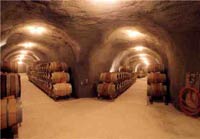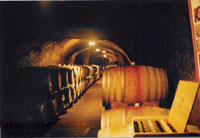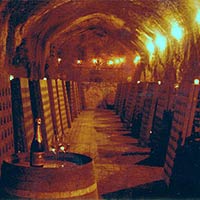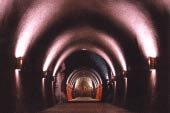|

Wine
Country Caves: Bigger, Badder, Deeper
The
Cave's the Thing
 |
| Robert
Sinskey Vineyards built by Nordby Wine Caves |
Good
wines love a well-built cave, and who could blame them? Damp, cool,
safe and still—they're an unmatched recipe for aging toward
perfection. But wait, the scene has shifted—mankind is taking
vino-culture underground.
Today,
new world wine caves are all the rage. More than one hundred exist
throughout Napa and Sonoma counties, making the California Wine
Country the most densely "tunneled" place on earth. Wine
caves come in all shapes, sizes, and ages from cavernous to downright
snug, from linear to spoked, from over-the-top ornate to simple
and utilitarian. Winemakers agree that caves are the ultimate in
wine storage. The constant cool temperature, high humidity, relatively
still air and darkness make for happy, profitable wines down the
road.
In
addition , a growing number of wineries are constructing entire
winemaking facilities underground, not just for aging barrels and
bottles, but as offices, tasting rooms, banqueting halls, laboratories,
bottling lines! "Wine-cave envy," may be surpassing Wine
Spectator ratings; some wineries seem to be trying to outdo
their competitors by creating larger, lower, deeper and more opulent
spaces than ever before.
Why
Wine Caves?
New
cave construction has become very popular for a variety of reasons.
"Caves make good economic sense," says Glen Ragsdale,
one of the leading building contractors, whose company has built
many of the wine caves throughout the wine country. "There
are vastly reduced energy costs, no heating, no air conditioning,
and the constant temperature and humidity saves between three to
six percent of wine evaporation per year." This amount can
add up to substantial savings. Wine caves retain an average temperature
of between 55 and 60 degrees, and an average relative humidity of
75 percent, which assists with winemaking quality control. The interior
of a cave presents absolutely perfect conditions for the creation
and preservation of wine. It is estimated that within seven years,
wine cave owners will realize a return on their investment due,
as compared to owners of above-ground facilities.
There
are many non-wine reasons wineries are constructing new facilities
below ground. "The county likes caves," says Paul Frommel,
former Director of New Project Development for Nordby
Wine Caves, speaking about Napa. "There are no view-shed
problems, and they'd rather have you go subterranean than build
a new above ground structure." Furthermore, agricultural land
is preserved, and a minimal footprint left on the land is a huge
advantage caves have over above-ground facilities. In fact, many
wineries have grape vines growing directly on top of caves. Neighbors
rarely complain about new caves, because little is visible to the
public, after the construction phase is completed. Another plus
is that caves virtually last forever, using extremely durable materials
including concrete, stone, no wood, and have constant temperatures
and humidity.
DEL DOTTO: Barrels, Candles and Music
 |
| Del
Dotto Winery cave |
Some
of the original wine caves in California date back to the 1880s,
with venerable Schramsberg and Beringer wineries boasting the oldest.
They were actually dug like mines, using picks, shovels and copious
amounts of human labor. These caves display a timelessness unlike
most contemporary facilities. The Del Dotto Winery, originally called
the Hedgeside Winery, also had caves dug in the 1880s. Located at
the foot of Atlas Peak Road, these caves provide one of the most
enjoyable cave experiences in the Napa Valley. Romantically candle-lit
on weekends, with soft music flowing through the irregularly chiseled
walls, Del Dotto Winery offers an idyllic setting. This facility
is also "barrel crazed," featuring a huge array of oaken
barrels from various regions. Their barrel tasting permits visitors
to not only sample but purchase wines directly from a specific barrel.
"This is awesome, the best personal tour in the valley,"
says Tracee Tulloh, visiting with friends from Los Gatos.
CLIFF LEDE: (S. ANDERSON)—A Combination of Old and New
 |
| Cliff
Lede Winery cave |
On
the Yountville Cross Road, near the Silverado Trail, sits Cliff
Lede (pronounce Cliff Lady) Winery, formerly the S. Anderson
Vineyard. Known for sparkling wines, the S. Anderson caves are among
the oldest of the modern-era caves in Napa. Fresh from his experiences
constructing BART, tunneler extraordinaire, Alf Burtleson, dug the
S. Anderson caves.
"People
have an emotional response to all caves, especially ours,"
says Michael Updegraff, General Manager at Cliff Lede. Indeed, these
caves have a tranquil quality, originally created for riddling bottles,
not barrels. There's even a small subterranean stage. "Alf
was a pioneer in going underground," said Updegraff. The Cliff
Lede caves are open every day, but are presently undergoing renovations
to install new lighting, drainage, and another portal.
QUINTESSA: Cave "Terroir"
| |
| Quintessa:
The most modern cave in Napa |
Quintessa
Winery is clearly the most modern cave in the Napa Valley. This
magnificent low-slung curved edifice can be seen on the Silverado
Trail, just across from Auberge
du Soleil. A self contained, gravity-fed facility, Quintessa
brings together an exquisite amalgam of form and function. And they
make some impressive wine, too.
The
entranceway's 20-foot glass doors reveal an efficient functioning
winery, while providing far more natural light than found elsewhere.
"This entire facility is very site specific," says Quintessa
architect Greg Warner, of San Francisco based Walker, Warner Architects.
"We used context to drive the form, but at the same time, the
profile was determined by how they wanted to store their wine."
The interior of the cave is slightly curved, barrels lining the
walls grace interior site lines. The elegant "enoteca"
is a smart stop for wine tasting. Quintessa, unlike most created
in a linear fashion, is designed around an axial theme, with no
dead ends. Warner says, "This cave has multiple points for
working, barrel storage, and moving around. It doesn't complicate
functionality." Does the objective of the cave help create
superlative wine? "Oh yes," states Warner. "It's
really about Cave Terroir." He is impassioned about this concept.
"It's the way the wine is selected here, processed here, created
here—the integrating arch, and the building itself—it's
all really about this place."
JARVIS: A River Runs Through It
 |
| Jarvis
cave tunneled into the scenic Vacas Mountains |
The
Jarvis Winery
cave sits high atop Monticello Road, in eastern Napa. An outdoor
garden setting gives no clue to what lies within, and a large parabolic
door is the only hint that a cave beckons. (The parabolic theme
continues throughout the caves, and is proudly displayed on the
Jarvis wine label.) The dark, attractive entranceway boasting medieval
sconces soon reveals the incredible 45,000-square- foot wine making
facilities inside: the first winemaking facility to be developed
completely below ground.
Visitors
will be amazed to find an actual waterfall and creek running through
the Jarvis caves. The underground waters were a lucky find when
drilling the caves. These flowing waters provide added moisture
as well as beauty. Deep within the facility lies the huge "Crystal
Chamber," glittering with amethyst and quartz. Tolkien's Dwarves
would be envious of the Jarvis Winery.
Owner
William Jarvis is pleased with the quality and economics of his
caves. "The cave is an insurance policy against damaged wine,"
he says. "A few days of elevated temperatures can damage wine
forever—best to keep it in a cool cave environment until the
day it ships."
Jarvis
also has suggestions for those planning new underground wine caves.
"Make more little chambers than you think you will ever need."
The Jarvis wines are gratifying, (try the Lake William Cab), and
the cave experience is one of Napa's hidden treats.
PALMAZ: Hearst Castle of the Wine Country
The
Palmaz caves are something altogether different. Giant eucalyptus
trees herald visitors into the property. This, the Xanadu of wine
caves, is something to behold, and will be worth a visit, if you
can get in, when it opens sometime in late 2004. "The initial
plan, was to make a complete, gravity flow facility underground,"
says Glen Ragsdale, Palmaz' cave builder, and owner of Ragsdale
Underground Associates. The project may have gotten out of hand.
Still,
seeing this incredible undertaking is like being inside the Channel
while under construction. Palmaz's tunnels are being dug on four
intertwined levels, with more than 140 feet between the highest
and lowest levels. Palmaz is even constructing a special waste water
treatment plant (as demanded by the county) to have a zero water
impact on the surrounding community. This future winery, off Hagen
Road, is scheduled to open in 2004, and will have 50,000 square
feet entirely underground. This $25 million project will hopefully
produce superlative wines. The elevator burrowing some 18 stories
deep into the bedrock will be the largest (though underground) in
all of Napa County.
Palmaz
will also house an 8,000-square-foot car museum, complete with over
40 rare racing Porsches, all belonging to winery owner, Dr. Julio
Palmaz. "This will add to the ambience," chuckles Glen
Ragsdale.
The
Dome Room at Palmaz is perhaps its most auspicious engineering feat.
The underground space is 55 feet high and 75 feet wide, and holds
24 large fermentation tanks, the upper 12 supported on an amazing,
mechanical lazy-susan type device. A computer controlled, gravity
feed system drops the grapes gently into the proper tank below.
When properly filled, the next tank rotates into place.
BOUTIQUE
CAVES
Smaller,
less ornate yet perfectly acceptable caves are popping up all over.
The newest cave in Napa is owned by Frazier
Winery. Owner Bill Frazier, a former airline pilot, runs a tight
one-man show on his winery and vineyard just south of Napa Valley.
This new, adobe-colored 10,000-square-foot shotcrete wine cave has
a full commercial kitchen, small banqueting facility and caters
to high-end tours. Frazier is thrilled with his new cave, and heartily
believes in the concept. "For every barrel in my cave, versus
in a building, I'll save an equivalent of one case of wine over
two years." And at $85 for his 2000 "Memento" Cabernet,
these savings can add up quickly.
Baldacci
Family Vineyards is another recently completed cave, located
in the Stag's Leap District. At 7,000 square feet, this cave took
six months to build. "First they used an auger, then some dynamite,"
says Carol Garret, president of Baldacci Family Vineyards. This
winery has no plans to open the caves to the public but wants to
keep the caves available for the original purpose, storage of wine
barrels. "Storage is always an issue, because you can never
have enough." Their 2000 Cabernet is a gem, and the future
looks good.
People
seem to like visiting wine caves, and there are many to choose from
throughout the wine country. Something primordial stirs when entering
a cave. Maybe it's the quiet ambience, the aroma, dim lighting and
ancient feeling, or even the sense of drama that exists inside the
earth. One thing is certain, and agreed upon worldwide: wines absolutely
love it.
by
Bob Ecker
|
